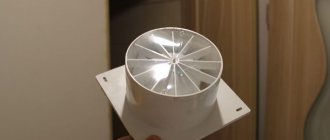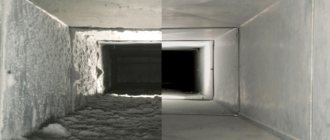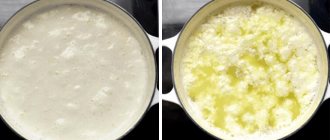Nowadays, it is impossible to imagine your life without ventilation systems. They are installed in industrial buildings, offices, educational institutions, shops, and apartments. The operation of these systems is unthinkable without the use of exhaust fans of various capacities. A widespread element of apartment ventilation is the kitchen hood. It can have different shapes, sizes, designs.
The amount of purified air in the room will depend on the calculation of the power of the kitchen hood fan.
How to find out the fan performance
Modern fan
When purchasing a ventilation device, everyone wants to know and check its performance. The productivity of the described device is the volume of air pumped over a certain unit of time. That's why everyone wants to buy a device with more performance! It is measured in “CFM”, which means cubic feet per minute or m³ (cubic meters) per hour.
An equally important characteristic of this device is its power, which is measured in “kW” and “kW”. In this case, the variable value is the rotation speed, measured in the number of revolutions produced per minute.
Calculation of the fan, or rather its performance, also involves:
- blade diameter;
- noise level;
- full pressure.
The fan performance is indicated on the packaging of the device or stated in the instructions supplied with it. Normally, such a device refreshes the air in the room every 4 minutes. An important indicator is the volume of available space. The larger it is, the greater the load on the described device. By the way, you can calculate the volume of a room where you need to “renew the air” using a simple school formula: multiplying the height by the width and length!
The required shift rate recommended by SNiP is the range from 10 to 12 times per hour. By multiplying the available volume of the room by any value from this range, you can obtain the required performance in a separate room. By summing the resulting value with calculations of the area for all rooms of the house, you can find out the required productivity for the entire living area.
In practice, the standards required by calculations are rarely implemented, so in real conditions everything is somewhat different, which concerns good air flow. So, for the minimum established rate of air exchange in a room, it is enough to open a window or rely on the draft created in the ventilation duct.
Kitchen exhaust fan
Bathrooms and kitchens require fans with higher performance or they must run longer here than in other rooms, since taking a shower and cooking leads to a change in the composition of the air, saturating it with water vapor and carbon monoxide. For such rooms, the operation of the device in a “reinforced hood” is suitable, which must be installed on the device.
An important role is played by the installation of an axial fan, which is a bladed blower that transmits mechanical energy from the rotation of the blades located on the impeller in the form of kinetic and potential energy. Calculation of the air exchange of axial fans is carried out taking into account the efficiency (efficiency factor), aerodynamic characteristics of the device and unit performance. This value may also be indicated in the instructions supplied with the device.
PRESSURE AND SECTION
The pressure and, accordingly, the speed of movement of air masses is affected by the cross-sectional area of the channels, as well as their configuration, the power of the electric fan and the number of transitions.
When calculating the diameter of the channels, the following values are empirically taken:
- For residential premises – 5.5 sq.cm. per 1 sq.m. area.
- For a garage and other industrial premises - 17.5 sq.cm. per 1 sq.m.
In this case, a flow speed of 2.4 – 4.2 m/sec is achieved.
How to increase fan performance
The presence of fresh air in the premises is the key to good work and excellent well-being of all household members. This can be organized by installing fan equipment in the room that can evenly cool the room. At the same time, its quiet operation, which does not create discomfort for others, is important.
It is desirable to create an unimpeded flow of air from the ceiling to the floor, which could be freely distributed around the entire perimeter of the room. Thanks to this, the device will heat up less and its performance will increase.
From a school physics course we know that cold air occupies the bottom of the room, and hot air occupies the top. Therefore, it is recommended to install an air outflow at the bottom of the room. The presence of active air outflow and inflow requires the installation of exhaust/injection fans of equal performance.
Ventilation system
You can increase the performance of the fan by switching it to efficient operation mode. In this case, the operation of the device should be minimal when household members are not at home. In other situations, it is recommended to increase the air supply in the room where people are. If there is an active cooking process in the kitchen and the shower is running for a long time, it is recommended to increase the local air supply in these rooms to the maximum. Such “smart” ventilation can quickly and efficiently exchange air in any room.
For the described ventilation system, a special control unit is equipped, which is connected to the processor. Sensors that can detect:
- degree of movement;
- amount of carbon dioxide;
- relative air humidity.
Responsible for the selected operating mode is the “control unit”, which sets the operating mode for the exhaust pumps. These devices can serve one or several rooms. The number of such devices depends on the area of the room. The hood from the kitchen is also connected here.
Kitchen hood
The advantage of using the described “smart” ventilation system is the correct regulation of the performance of exhaust fans, allowing you to reduce the amount of air pumped over 24 hours by almost half. It also consumes less electricity, which is a big plus for family budgets.
Air change rate
The multiplicity for premises of different types is determined as follows:
| Room type | Multiplicity |
| Bakery | 20-30 |
| Greenhouse | 25-50 |
| Office | 6-8 |
| Bathroom, shower | 3-8 |
| Salon | 10-15 |
| Restaurant, bar | 6-10 |
| Bedroom | 2-4 |
| Lobby | 3-5 |
| Classroom at school | 2-3 |
| Cafeteria | 10-12 |
| A hospital room | 4-6 |
| Shop | 8-10 |
| Basement | 8-12 |
| Kitchen in a house or apartment | 10-15 |
| Gym | 6-8 |
| Attic space | 3-10 |
| Catering kitchen | 15-20 |
| Pantry | 3-6 |
| Changing room with shower | 15-20 |
| Laundry | 10-15 |
| Toilet in the house, in the apartment | 3-10 |
| Conference hall | 8-12 |
| Living room | 3-6 |
| Billiard room | 6-8 |
| Public toilet | 10-15 |
| Garage | 6-8 |
| Meeting room | 4-8 |
| Utility room | 15-20 |
| Library | 3-4 |
| Dining room | 8-12 |
Table for calculating the minimum performance of the hood relative to the volume of the kitchen.
The highest multiplicity is chosen for use in rooms with many people, high humidity and temperature, a lot of dust and strong odors. In a kitchen with an electric hob, you can choose a lower indicator, with a gas stove - a higher one. This is due to the fact that gas emits combustion products when the stove is turned on. The fan, selected taking into account the above data, can be mounted in a wall, window, or ceiling of the room.
How to measure fan performance
A lot depends on the performance of the ventilation system: both the condition of the house and its general well-being. Thus, constant ventilation of the home by opening windows leads to condensation on the windows and walls, and also stimulates the formation of mold in the corners. An insufficient supply of fresh air negatively affects the condition of human lungs, manifesting itself in the development of corresponding diseases and pathologies. Children growing up without ventilation can compromise their health for the rest of their lives.
To measure the performance of a ventilation system, you can use the following methods:
Measuring room parameters
- Self-measurements. Using a tape measure, measure the size of the room, determining its volume in meters. You can use a simple school formula to calculate the area of a room: the product of height, width and length. The result obtained should be expressed in meters, which will be the total volume of the room.
- Obtaining information from reliable sources. BTI documents contain all the necessary information about the area of premises. The volume of all housing and heated area is given there. You can also find the height from ceiling to floor and calculate the volume of a separate room.
Next, the value characterizing air exchange is calculated. In this case, the volume of a separate room should be multiplied by the required number of air updates occurring within an hour. The number of air updates can be found in building codes and regulations (SNiP).
In this case, you should take the maximum number of updates in order to more accurately calculate the required power of the exhaust duct.
At home, the required ventilation device is selected based on the resulting air exchange area. Standard ventilation ducts have a low air exchange capacity. The situation can be helped by installing a recirculation exhaust system that can pass air through filters, sending it back into the room.
Scheme of installation of natural and forced ventilation
If the house does not have a ventilation duct, then the exhaust fan can be installed in a wall opening or on the ceiling. The junction of the ceiling and wall is also suitable for these purposes. In this case, you can install a device with a lower power value.
PHYSICAL COMPONENTS OF CALCULATIONS
According to the method of operation, ventilation circuits are currently divided into:
- Exhaust. To remove used air.
- Inlet. To let in clean air.
- Recuperative. Supply and exhaust. Remove the used one and bring in a clean one.
In the modern world, ventilation schemes include various additional equipment:
- Devices for heating or cooling supplied air.
- Filters for purifying odors and impurities.
- Devices for humidification and air distribution throughout rooms.
When calculating ventilation, the following values are taken into account:
- Air consumption in cubic meters/hour.
- Pressure in air channels in atmospheres.
- Heater power in kW.
- Cross-sectional area of air channels in sq. cm.
Exhaust ventilation in the kitchen
Thanks to kitchen exhaust ventilation, it is possible to carry out air exchange in the most problematic areas of the room. For example, improving the air quality in the kitchen during food preparation. Not only the general well-being of the people living here, but also the condition of the walls in the living space depends on the use of such structures. Technical standards recommended by SNiP for organizing ventilation:
- 60 m³ per hour (electric stove);
- 100 m³ per hour (gas hobs).
This value should be multiplied by the area of the room to find out the required performance of the ventilation system. It is based on the obtained value that a device with an appropriate electric motor should be selected. Installing a hood above the hob allows for additional air exchange, preventing the spread of food aromas throughout the home. When connecting these elements, you should select all components correctly, with equal sections.
When the kitchen hood is installed correctly, the ventilation shaft with the attached device is connected. Thanks to this, the harmful chemical compounds formed during cooking are completely removed from the component.
Basic formulas for aerodynamic calculations
The first step is to make an aerodynamic calculation of the highway. Let us remind you that the main air duct is considered to be the longest and most loaded section of the system. The fan is selected based on the results of these calculations.
Just don’t forget about linking the remaining branches of the system
It is important! If it is not possible to make connections on the branches of the air ducts within 10%, you need to use diaphragms. The diaphragm resistance coefficient is calculated using the formula:
If the discrepancy is more than 10%, when a horizontal air duct enters a vertical brick duct, rectangular diaphragms must be placed at the junction.
The main task of the calculation consists of finding the pressure loss. At the same time, I select the optimal size of the air ducts and control the air speed. The total pressure loss is the sum of two components - pressure loss along the length of the air ducts (due to friction) and losses in local resistance. They are calculated using the formulas
These formulas are correct for steel air ducts; for all others, an correction factor is introduced. It is taken from the table depending on the speed and roughness of the air ducts.
For rectangular air ducts, the calculated value is the equivalent diameter.
Let's consider the sequence of aerodynamic calculation of air ducts using the example of offices given in the previous article using formulas. And then we’ll show you what it looks like in Excel.
Calculation example
According to calculations, the air exchange in the office is 800 m3/hour. The task was to design air ducts in offices no more than 200 mm high. The dimensions of the room are given by the customer. Air is supplied at a temperature of 20°C, air density 1.2 kg/m3.
It will be easier if the results are entered into a table of this type
First we will do an aerodynamic calculation of the main line of the system. Now everything is in order:
We divide the main line into sections along the supply grilles. We have eight grates in the room, each with a capacity of 100 m3/hour. There were 11 sections. We enter the air flow at each section into the table.
- We record the length of each section.
- The recommended maximum speed inside the duct for office premises is up to 5 m/s. Therefore, we select the size of the air duct so that the speed increases as it approaches the ventilation equipment and does not exceed the maximum. This is done to avoid noise in ventilation. Let’s take an air duct of 150x150 for the first section, and 800x250 for the last section.
V1=L/3600F =100/(3600*0.023)=1.23 m/s.V11= 3400/3600*0.2= 4.72 m/s
We are satisfied with the result. We determine the dimensions of the air ducts and the speed using this formula in each section and enter them into the table.
- We begin calculating pressure losses. We determine the equivalent diameter for each section, for example the first dе=2*150*150/(150+150)=150. Then we fill in all the data necessary for the calculation from the reference literature or calculate: Re=1.23*0.150/(15.11*10^-6)=12210. λ=0.11(68/12210+0.1/0.15)^0.25=0.0996 The roughness of different materials is different.
- Dynamic pressure Pd=1.2*1.23*1.23/2=0.9 Pa is also recorded in the column.
- From Table 2.22 we determine the specific pressure loss or calculate R=Pd*λ/d= 0.9*0.0996/0.15=0.6 Pa/m and enter it in a column. Then at each section we determine the pressure loss due to friction: ΔРtr=R*l*n=0.6*2*1=1.2 Pa.
- We take local resistance coefficients from reference literature. In the first section we have a grille and an increase in the air duct in the sum of their CMC is 1.5.
- Pressure loss in local resistances ΔРм=1.5*0.9=1.35 Pa
- We find the amount of pressure loss in each section = 1.35+1.2=2.6 Pa. And as a result, the pressure loss in the entire line = 185.6 Pa. by that time the table will look like
Next, the remaining branches are calculated using the same method and linked. But we’ll talk about this separately.
Design air exchange
The calculated value of air exchange is taken to be the maximum value from calculations of heat input, moisture input, harmful vapors and gases, sanitary standards, compensation for local exhaust hoods and the standard air exchange rate.
The air exchange of residential and public premises is usually calculated according to the air exchange rate or according to sanitary standards.
After calculating the required air exchange, an air balance of the premises is compiled, the number of air distributors is selected, and an aerodynamic calculation of the system is made. Therefore, we advise you not to neglect the calculation of air exchange if you want to create comfortable conditions for your stay in the room.
general description
Fans are machines designed to move various air-gas mixtures with an increase in their pressure to a maximum value of 12-15 kPa. Distinctive features of the fans are a simple single-stage design and operation at low peripheral shaft speeds. Fans consist of a housing, an impeller with blades mounted on a shaft inside the housing, and a drive. Electric motors are used to drive fans.
Fans are widely used both in everyday life and in industry. Industrial fans are subject to certain requirements due to more stringent operating conditions. In addition to compliance with the parameters of the ongoing technological process, industrial fans must meet high requirements for design reliability and safety.
Fans are used to transport various air-gas mixtures, which may differ in critical temperatures, abrasive properties, dust and moisture content. Therefore, an essential criterion in the manufacture of fans is the correct choice of material design.











